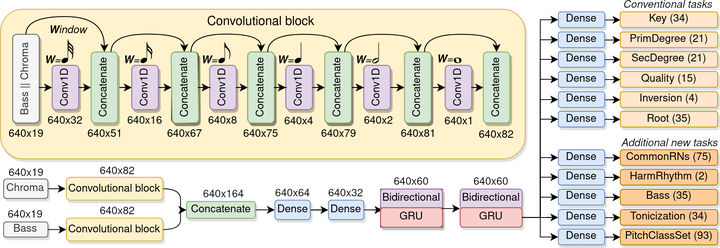AugmentedNet: A Roman Numeral Analysis Network with Synthetic Training Examples and Additional Tonal Tasks
 AugmentedNet. Diagram taken from the paper.
AugmentedNet. Diagram taken from the paper.Abstract
AugmentedNet is a new convolutional recurrent neural network for predicting Roman numeral labels. The network architecture is characterized by a separate convolutional block for bass and chromagram inputs. This layout is further enhanced by using synthetic training examples for data augmentation, and a greater number of tonal tasks to solve simultaneously via multitask learning. This paper reports the improved performance achieved by combining these ideas. The additional tonal tasks strengthen the shared representation learned through multitask learning. The synthetic examples, in turn, complement key transposition, which is often the only technique used for data augmentation in similar problems related to tonal music. The name ‘AugmentedNet’ speaks to the increased number of both training examples and tonal tasks. We report on tests across six relevant and publicly available datasets: ABC, BPS, HaydnSun, TAVERN, When-in-Rome, and WTC. In our tests, our model outperforms recent methods of functional harmony, such as other convolutional neural networks and Transformer-based models. Finally, we show a new method for reconstructing the full Roman numeral label, based on common Roman numeral classes, which leads to better results compared to previous methods.